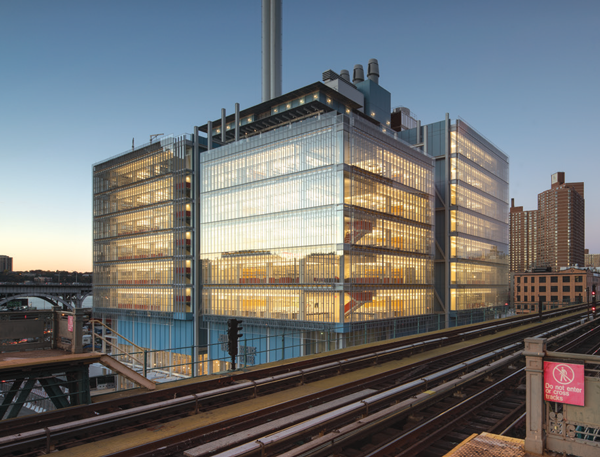Trending
Outmatched in majesty
Columbia University’s two new Renzo Piano-designed buildings don’t hold a candle to the school’s original campus, but they aren’t equals either

It is hard to imagine a greater difference — in formal, philosophical or societal terms — than the one between Columbia University’s main campus in Morningside Heights, begun at the end of the 19th century, and the new campus taking shape half a mile north in Manhattanville.
The original campus, which was conceived by Charles Follen McKim of McKim, Mead & White, is a quintessential example of Beaux-Arts city planning — or, as it was known in the United States, the City Beautiful Movement. The very syntax of the name, City Beautiful rather than Beautiful City, reveals all you need to know. It has an aspirational, vaguely feudal or at least archaic tinge. The campus is not only robed in mythology, but it also has an unflappable symmetry and hierarchical distribution of classically designed buildings.
Nothing could be more opposed to the dominant thrust of contemporary taste at the university’s new West Harlem outpost. Yet, the new campus sums up the present cultural and political moment as fully, if not quite as thrillingly, as its predecessor.
While the original campus is separated from the outside world by ivy-mantled walls and gates, the new campus is deeply (and intentionally) woven into its surrounding urban fabric: The elevated No. 1 train runs in its shadow and noisily interacts with visitors coming and going at the new, largely transparent buildings, which are open at street level.
The 17-acre under-construction area — which was designed by Pritzker Prize- winning architect Renzo Piano, along with Skidmore, Owings & Merrill, and is largely bounded by 125th and 133rd streets west of Broadway — not only rejects the symmetry of the older campus, but it does not even feel cohesively planned. Although it will ultimately contain nine buildings and 6.8 million square feet of new, state-of-the-art, environmentally sustainable academic space, the buildings do not appear to have been arranged in any appreciable order. They are so vastly different from the Morningside Heights campus that they do not even occupy a common axis.

The Lenfest Center for the Arts
So far, two of the buildings are complete: the 60,000-square-foot Lenfest Center for the Arts and the 450,000-square-foot Jerome L. Greene Science Center, both of which were designed by Piano and share a plaza on 125th Street and Broadway.
The shape of the Lenfest Center — a hulking gray monolith that houses a 150-seat theater, a performance space and art galleries, among other things — recalls the new (and far larger) Whitney Museum in the trendy Meatpacking District, also designed by Piano. But the Lenfest does not have the Whitney’s spectacular views and interlocking stairways. In addition, the rows of ribbon windows at the Lenfest produce a stronger sense of mural heaviness than exists at the Whitney, even though the newer building is little more than a massing of glass and metal sheeting.
The problem with the Lenfest Center, which opened to the public this spring, is that there is almost nothing beautiful or delightful about it. It evokes nothing. Even its utilitarian blockishness doesn’t resonate with any evocative tedium.
The one exception is the stone-paved and fastidiously square plaza in front of the building — especially when seen from the sixth-floor gallery — that, as so often is the case in Piano’s work, translates an archaic European form into a contemporary amenity.
By contrast, the Jerome L. Greene Science Center, a neuroscience research facility that is home to the Mortimer B. Zuckerman Mind Brain Behavior Institute, is more graceful and elegant. Its glass curtain walls and metallic surface articulation recall Piano’s New York Times Building on Eighth Avenue. It achieves a gossamer refinement that, in contrast to its neighbor, seems to convey an aesthetic point.
At both buildings, Piano has rejected the male and pale forms that dominate the Morningside Heights campus’s domes, architraves and ionic columns. Instead, he’s opted for a more industrial idiom — seemingly intended to mesh with the spirit of the area’s earlier building stock, even though most of it has been torn down.
Diller Scofidio + Renfro, another go-to architecture firm in contemporary New York City, recently completed the Vagelos Education Center for Columbia’s medical school, a few miles north in Washington Heights, in an aggressive Deconstructivist style with truculent asymmetries and tilted floors. But that style appears to be less welcome in Manhattanville, where Piano’s wraithlike visions of crystalline curtain walls hold sway.
Still, there is no good reason why the buildings on the new campus could not have been conceived in a coordinated way, especially since Piano has designed several of them and because they invoke the neomodernist style that’s an architectural default today. If all of the buildings had drawn inspiration from the Jerome L. Greene building, the collection of structures would have lost some diversity, but the overall results would have been better.
As for the sixth-floor gallery space at the Lenfest Center for the Arts, it feels spacious, airy — and antiseptic. With high ceilings and light flooding in from all sides, it seems made for installation art. The problem is that the invaluable Miriam and Ira D. Wallach Art Gallery — which until now was tucked away on Columbia’s main campus — has always been most distinguished for its small-scale archival shows, especially those about architecture. Such exhibits will look vastly outmatched and perhaps even pointless in the new space. Or maybe (as suggested by the inaugural show, “Uptown,” a collection of works by Harlem artists), the Wallach intends to abandon its unglamorous-but-infinitely-admirable earlier orientation in the name of accessibility, relevance and foot traffic.
The good news is that even if the new West Harlem campus does not equal the majesty of the Morningside Heights campus, it will create a center of intense intellectual activity in a part of the city that has been largely overlooked and forgotten for 100 years.




